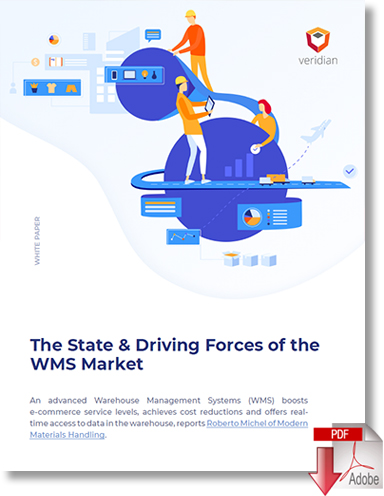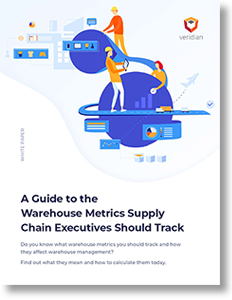How to Maximize WMS to Increase Ecommerce ROI
A key issue that comes to the forefront of any discussion on handling ecommerce demand will always involve warehouse management system (WMS) or other supply chain system upgrades.
System upgrades are a terrific way to enhance productivity, increase efficiency, and provide real benefits to workers and stakeholders.
Unfortunately, merely implementing a WMS itself is not enough to truly maximize its value.
Supply chain leaders need to understand the challenges of implementation, how using a WMS maximizes profitability in the age of ecommerce, and a few tips to ensure its success.
WMS Challenges That Decrease ROI from Ecommerce
Challenges of implementing a WMS, including employee resistance, can harm new system ROI.
In addition, these challenges can lead to a hostile work environment, higher employee turnover and higher costs of fulfilling orders.
Roberth Karlsson, Site manager, warehouse and distribution, at K.W. Bruun Logistik AB in his LinkedIn post “The challenges of e-commerce and omnichannel in warehouse production” says;
“I often encounter colleagues within warehouse operations who talk about the suppliers 'promotional offers' that purchasing departments often accept. Large quantities ordered home, handled, and then lie on stock for months and sometimes years. If you calculate the inventory carrying charge, it often does not pay to accept and buy these 'promotional offers'”
Some of the top challenges of using a WMS for ecommerce include:
- Scalability
- Single-item purchases
- Cybersecurity
- Changing state of logistics
- Poor employee performance
- Labor-intense receiving and put away processes
- Lack of visibility in data and inventory
- The proliferation of SKUs
- Limited labor resources
Why a WMS is Key to Ecommerce ROI
The use of an integrated WMS is the best way to overcome the challenges in implementation.
As the system impacts the operation, workers will understand its value. Modern WMS platforms allow for full scalability, and cloud-based security alleviates many cybersecurity concerns.
Meanwhile, the changing state of logistics will require more integration with new systems, including those created by third-party logistics providers (3PLS). Instead of trying to handle each challenge with antiquated, legacy systems, supply-chain leaders should seriously consider implementing a new WMS and letting its benefits do the proverbial talking.
Of course, following a few best practices to better leverage a WMS will always help.
Best Practices to Maximize WMS Value for Ecommerce
As explained in the Supply Chain 24/7 article “7 Ecommerce Enabled Warehouse Best Practices” by Bridget McCrea, some of the best practices for leveraging a WMS for e-commerce include:
- Rethink how you pick orders. Traditional methods of picking a single order to time are obsolete in the age of e-commerce.
- Integrate facilities. Integrating your facilities with your WMS ensures minimal disruption for planned maintenance and other needs.
- Design the warehouse with an omnichannel mindset. Omnichannel requires an entirely different mindset, knowing products may be fulfilled at and sent to an infinite number of locations.
- Automate WMS processes. Automating data entry and tracking processes can reduce the opportunity for error and ensure accuracy and all data insights.
- Know the data behind your operation. Understanding the data behind the action, including employee performance, cycle times, metrics, and other key performance indicators will enhance ROI.
- Take advantage of existing retail space to fulfill ecommerce orders. Vacant retail space abandoned by other retailers is an opportunity to move order fulfillment closer to consumers, especially in urban centers.
- Connect your WMS to customer service portals. As explained by Erhan Musaoglu via DC Velocity, automatically tracking consumer behaviors helps you connect and understand their needs/values.
Get the Most From Your WMS With the Right Supply Chain Systems Partner
Finding the best way to maximize return on investment for your WMS can be difficult, but it is possible.
To truly augment the capability of your WMS and achieve the most significant ROI, you must integrate systems and understand how to use and apply data. Veridian can help you with this process. Reach out to Veridian supply chain system experts today.
Related Article: Supply Chain Management Interest for a Cloud-Based Warehouse Management System on the Rise
Related White Papers
The State & Driving Forces of the WMS Market New!
In this white paper, you’ll learn about the state of the warehouse management systems market, why demand for cloud-based systems will shape the wms market and the driving forces behind the new wms adoption. Download Now!
Strategic Supply Chain Considerations in the Quest to Go Omnichannel
This white paper describes how, from retailers to manufacturers, as well as every business involved in sales in between, the omnichannel supply chain is a goal to achieve. Download Now!
Warehouse Metrics Supply Chain Execs Should Track
In this white paper from Veridian, you’ll learn the Warehouse Metric you should be tracking as a supply chain executive to aid you in your quest to continually improve and root out inefficiencies in your warehouses. Download Now!
Warehouse Management System Implementation Pre-Design: Challenge the Status Quo
In this WMS implementation pre-design white paper you will learn about the components of the pre-design phase including participant planning, subject matter expert preparation, application access, and much more. Download Now!
More Veridian Resources
Article topics
Email Sign Up
























